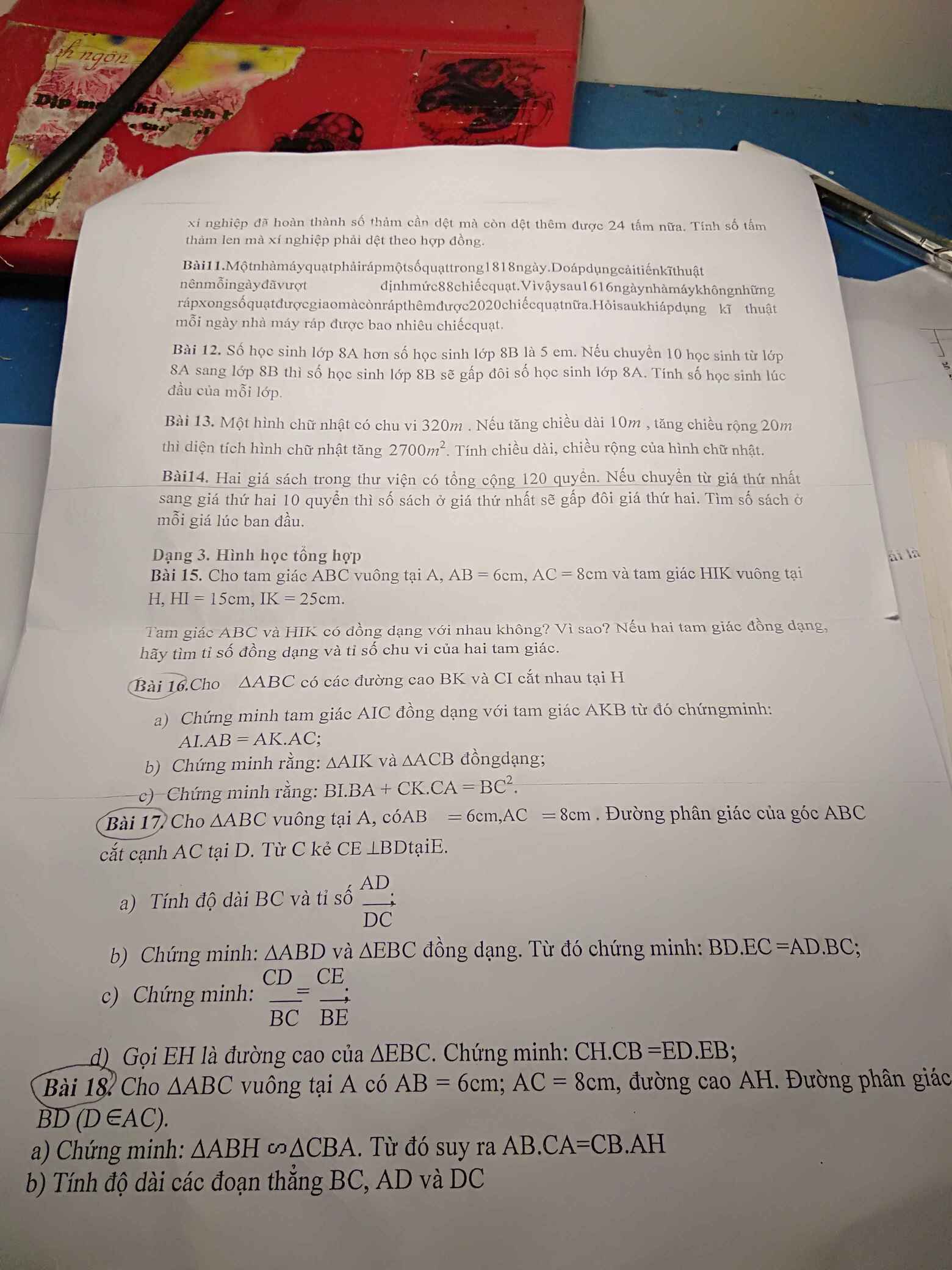
Hãy nhập câu hỏi của bạn vào đây, nếu là tài khoản VIP, bạn sẽ được ưu tiên trả lời.


6.
\(\Leftrightarrow x^2+4x+3>m\) ; \(\forall x>1\)
\(\Leftrightarrow m< \min\limits_{x>1}\left(x^2+4x+3\right)\)
Xét hàm \(f\left(x\right)=x^2+4x+3\) với \(x>1\)
\(-\dfrac{b}{2a}=-2< 1\) ; \(f\left(1\right)=8\Rightarrow f\left(x\right)>8\) ; \(\forall x>1\)
\(\Rightarrow m\le8\)
7.
Do C thuộc d nên tọa độ có dạng: \(C\left(-2c-1;c\right)\Rightarrow\left\{{}\begin{matrix}\overrightarrow{AB}=\left(4;6\right)\\\overrightarrow{CA}=\left(2c;1-c\right)\end{matrix}\right.\)
\(AB\perp AC\Leftrightarrow\overrightarrow{AB}.\overrightarrow{AC}=0\Leftrightarrow4.2c+4\left(1-c\right)=0\)
\(\Leftrightarrow4c+4=0\Rightarrow c=-1\Rightarrow C\left(1;-1\right)\)
b.
\(AB=\sqrt{4^2+6^2}=2\sqrt{13}\)
Phương trình đường thẳng AB qua A và nhận \(\left(3;-2\right)\) là 1 vtpt có dạng:
\(3\left(x+1\right)-2\left(y-1\right)=0\Leftrightarrow3x-2y+5=0\)
Do d thuộc d nên tọa độ có dạng: \(D\left(-2d-1;d\right)\)
\(S_{ABD}=\dfrac{1}{2}AB.d\left(D;AB\right)=50\)
\(\Leftrightarrow\dfrac{\sqrt{13}\left|3\left(-2d-1\right)-2d+5\right|}{\sqrt{3^2+\left(-2\right)^2}}=50\)
\(\Leftrightarrow\left|-8d+2\right|=50\Rightarrow\left[{}\begin{matrix}d=-6\\d=\dfrac{13}{2}\end{matrix}\right.\) \(\Rightarrow\left[{}\begin{matrix}D\left(11;-6\right)\\D\left(-14;\dfrac{13}{2}\right)\end{matrix}\right.\)
2.
a, Gọi \(C=\left(-2m-1;m\right)\) là điểm cần tìm
\(AB=2\sqrt{13};AC=\sqrt{5m^2-2m+1};BC=\sqrt{5m^2+2m+65}\)
Ta có \(BC^2=AB^2+AC^2\)
\(\Leftrightarrow5m^2+2m+65=52+5m^2-2m+1\)
\(\Leftrightarrow m=-3\)
\(\Rightarrow C=\left(5;-3\right)\)
b, Gọi \(D=\left(-2n-1;n\right)\) là điểm cần tìm
Đường thẳng AB có phương trình \(\dfrac{x+1}{4}=\dfrac{y-1}{6}\Leftrightarrow3x-2y+5=0\)
Khoảng cách từ \(D\) đến \(AB\):
\(d\left(D;AB\right)=\dfrac{\left|3\left(-2n-1\right)-2n+5\right|}{\sqrt{3^2+2^2}}=\dfrac{\left|-8n+2\right|}{\sqrt{13}}\)
\(S_{ABC}=\dfrac{1}{2}.\dfrac{\left|-8n+2\right|}{\sqrt{13}}.2\sqrt{13}=50\)
\(\Rightarrow\left|4n-1\right|=25\)
\(\Leftrightarrow\left[{}\begin{matrix}n=-6\\n=\dfrac{13}{2}\end{matrix}\right.\)
\(\Rightarrow\left[{}\begin{matrix}N=\left(11;-6\right)\\N=\left(-14;\dfrac{13}{2}\right)\end{matrix}\right.\)

ĐKXĐ: ...
Với \(\left[{}\begin{matrix}x=0\\y=0\end{matrix}\right.\) ko phải nghiệm
\(\Leftrightarrow\left\{{}\begin{matrix}2-\dfrac{1}{2x+y}=\dfrac{2}{\sqrt{y}}\\2+\dfrac{1}{2x+y}=\dfrac{2}{\sqrt{x}}\end{matrix}\right.\)
Lần lượt cộng vế với vế và trừ vế cho vế 2 pt ta được:
\(\left\{{}\begin{matrix}2=\dfrac{1}{\sqrt{x}}+\dfrac{1}{\sqrt{y}}\\\dfrac{1}{2x+y}=\dfrac{1}{\sqrt{x}}-\dfrac{1}{\sqrt{y}}\end{matrix}\right.\)
Nhân vế với vế:
\(\dfrac{2}{2x+y}=\left(\dfrac{1}{\sqrt{x}}+\dfrac{1}{\sqrt{y}}\right)\left(\dfrac{1}{\sqrt{x}}-\dfrac{1}{\sqrt{y}}\right)\)
\(\Leftrightarrow\dfrac{2}{2x+y}=\dfrac{1}{x}-\dfrac{1}{y}\)
\(\Leftrightarrow2x^2+xy-y^2=0\)
\(\Leftrightarrow\left(x+y\right)\left(2x-y\right)=0\)
\(\Leftrightarrow...\)

8:
\(=\dfrac{cos10-\sqrt{3}\cdot sin10}{sin10\cdot cos10}=\dfrac{2\left(\dfrac{1}{2}\cdot cos10-\dfrac{\sqrt{3}}{2}\cdot sin10\right)}{sin20}=\dfrac{sin\left(30-10\right)}{sin20}=1\)
10:
\(=\left(2-\sqrt{3}\right)^2+\left(2+\sqrt{3}\right)^2\)
=7-4căn 3+7+4căn 3=14
12:
\(=cos^270^0+\dfrac{1}{2}\left[cos60-cos140\right]\)
\(=cos^270^0+\dfrac{1}{2}\cdot\dfrac{1}{2}-\dfrac{1}{2}\cdot2cos^270^0+\dfrac{1}{.2}\)
=1/4+1/2=3/4

1.1
Pt có 2 nghiệm trái dấu và tổng 2 nghiệm bằng -3 khi:
\(\left\{{}\begin{matrix}ac< 0\\x_1+x_2=-3\end{matrix}\right.\)
\(\Leftrightarrow\left\{{}\begin{matrix}2\left(m+2\right)< 0\\\dfrac{2m+1}{m+2}=-3\end{matrix}\right.\)
\(\Leftrightarrow\left\{{}\begin{matrix}m< -2\\m=-\dfrac{7}{5}\end{matrix}\right.\)
\(\Rightarrow\) Không tồn tại m thỏa mãn
b.
Pt có nghiệm kép khi:
\(\left\{{}\begin{matrix}m+2\ne0\\\Delta=\left(2m+1\right)^2-8\left(m+2\right)=0\end{matrix}\right.\)
\(\Leftrightarrow\left\{{}\begin{matrix}m\ne-2\\4m^2-4m-15=0\end{matrix}\right.\)
\(\Rightarrow\left[{}\begin{matrix}m=\dfrac{5}{2}\\m=-\dfrac{3}{2}\end{matrix}\right.\)


Câu 1: Vì (d') vuông góc với (d) nên \(a\cdot\dfrac{-1}{3}=-1\)
hay a=3
Vậy: (d'): y=3x+b
Thay x=4 và y=-5 vào (d'), ta được:
b+12=-5
hay b=-17

Câu 1:
TXĐ:D=R
\(f\left(-x\right)=2\cdot\left(-x\right)^4-3\cdot\left(-x\right)^2+1\)
\(=2x^4-3x^2+1=f\left(x\right)\)
=>f(x) là hàm số chẵn

a) \(d\left(A;\Delta\right)=\dfrac{\left|4.1-3.3+2\right|}{\sqrt{4^2+\left(-3\right)^2}}=\dfrac{3}{5}\)
b) \(\overrightarrow{AB}=\left(-3;-2\right)\) là VTCP của đường thẳng d
PT tham số của d: \(\left\{{}\begin{matrix}x=1-3t\\y=3-2t\end{matrix}\right.\left(t\in R\right)\)
c) Đường tròn (C) có bán kính \(R=AB=\sqrt{\left(1+2\right)^2+\left(3-1\right)^2}=\sqrt{13}\)
PT đường tròn (C): \(\left(x-1\right)^2+\left(y-3\right)^2=13\)









Chọn A
bài 4 ạ